As with previous followers joining this blog, it is time to greet interdomin with a purposely-written post. Welcome!
A little history
Spain had had a lively automotive industry at an early time, but it was virtually wiped out by the effects of the competition offered by imported cars, the world economic crisis that followed the Wall Street crash and three years of civil war. In 1950, the Spanish authorities decided to resume the production of an automobile on the national soil, and sought Fiat’s assistance. In November 1953, the first SEAT (Sociedad Española de Automóviles de Turismo, or “Touring Cars Spanish Company”) was assembled in Barcelona from parts shipped from Italy; the car, named Seat 1400, was virtually identical to the new Fiat 1400 mid-range saloon.
By 1960, the bulbous, bathtub-styled 1400 was looking old, even on a virtually closed market as the Spanish one. Though this initial car remained in production for a few more years, a new 1400C, technically similar but totally different on the outside, was released. The 1400C was actually based on the new 1800 and 2100 six-cylinder saloons Fiat had introduced the year before; the Seat management immediately decided to adopt their elegant Pininfarina body, while sticking to the trusted 1.4-litre four, much better suited to the means of the average Spanish motorist of the time.
In 1963, a roomy estate version was added to the 1400C range, while a Seat 1500 based on the Fiat 1500L, a simplified and more economical version of the 1800/2100, was also introduced. Production of all 1400 models was stopped during the following year, the estate version being maintained in production with the 1.5-litre engine fitted.
When in 1968 Seat introduced its 124, based on the Fiat bearing the same name, the attention of most customers switched to this modern vehicle, compared to which the 1500 suddenly looked antiquated. Despite this, the old car kept a strong following when it came to commercial purposes. Spacious and chrome-laden, the 1500 made a popular taxi on the streets of all Spanish cities, while Seat had developed an indigenous pickup variant of the car. Furthermore, the Spanish manufacturer introduced a diesel version, powered by a 1.8-litre provided by Mercedes-Benz. The engines from this diesel pioneer were known to offer remarkable fuel economy and unbeatable reliability and durability, albeit at the cost of abysmal performance. Later, a 2.0-litre Perkins also became available. Both became favourites among Spanish taxi drivers.
Despite a last-minute facelift, the 1500 receiving in 1969 the quad-headlight front of the Fiat 2300, the model retired in 1972, giving way to the Seat 132. Production tally stood at 48,000 for the Seat 1400C, and 135,000 for the Seat 1500, mostly sold on the domestic market. The car today remains as an icon of an era of the Spanish motoring history and, furthermore, of Spanish history as a whole.
About the model
With some logic, Altaya catered to the Spanish public with many variants of Seat 1500 saloons and estates. Unfortunately, those are rather hard to find outside of Spain. Right now, I have to content myself with the most common of them all.
Model: Seat 1500
Year: 1971
Maker: Ixo
Scale: 1/43
Distributed by: Altaya as no.1 of its Nuestros Queridos Coches press series
Acquired: new with neither box nor stand (probably a production overrun or quality control reject), in December 2006, in Hong Kong, S.A.R.
Too bad Altaya doesn’t sell models as this one outside of Spain. They’re probably right in thinking that the small number of collectors interested in, or even having heard of, the Seat 1500 outside of its native country is rather slim, but as of myself I grabbed this one as soon as I found it. No regret whatsoever: this die-cast is splendid, correctly detailed and painted in a superb dark blue hue. A 14/20 rating seems amply justified to me.
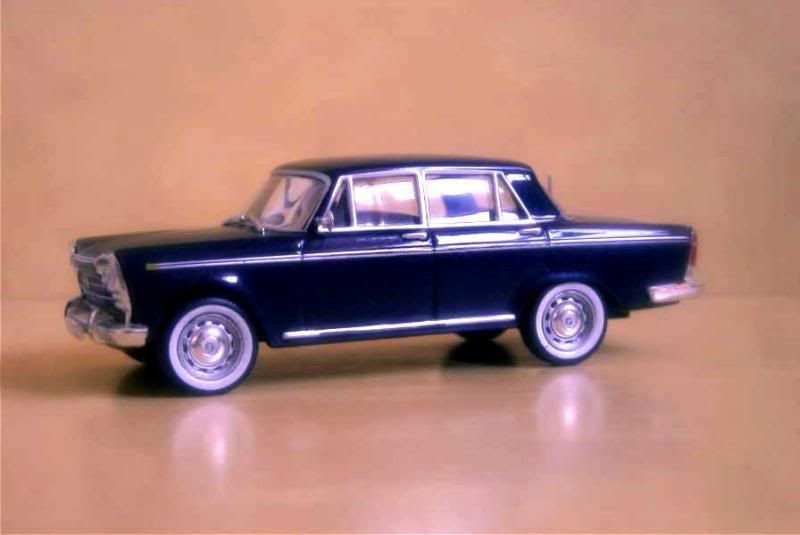
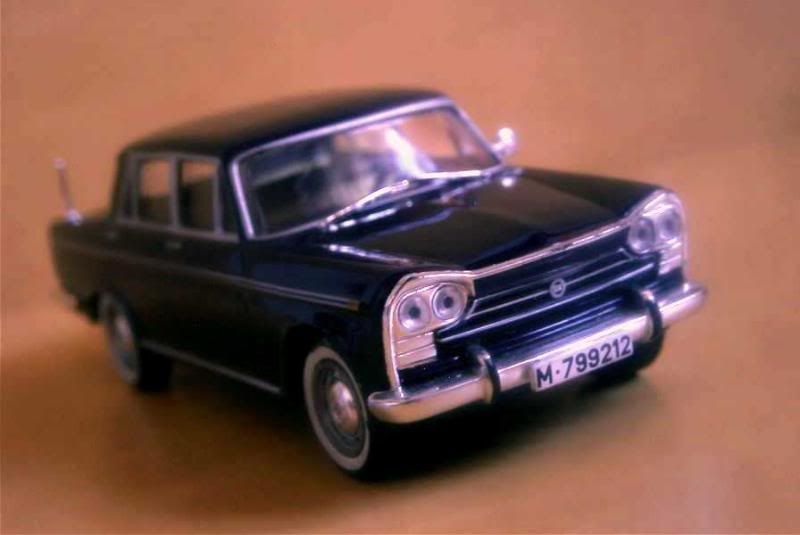

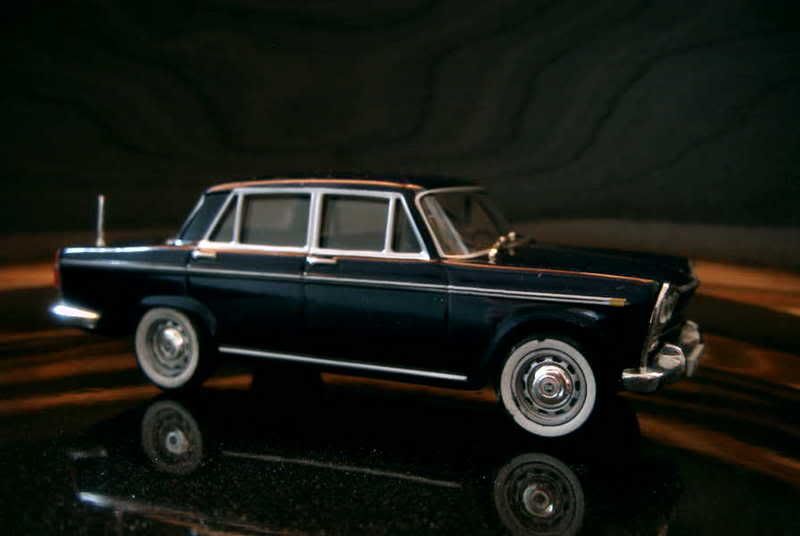
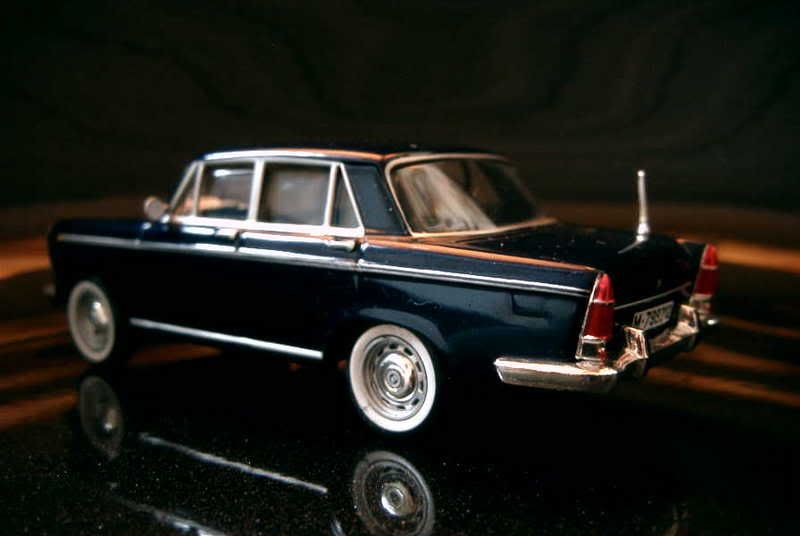
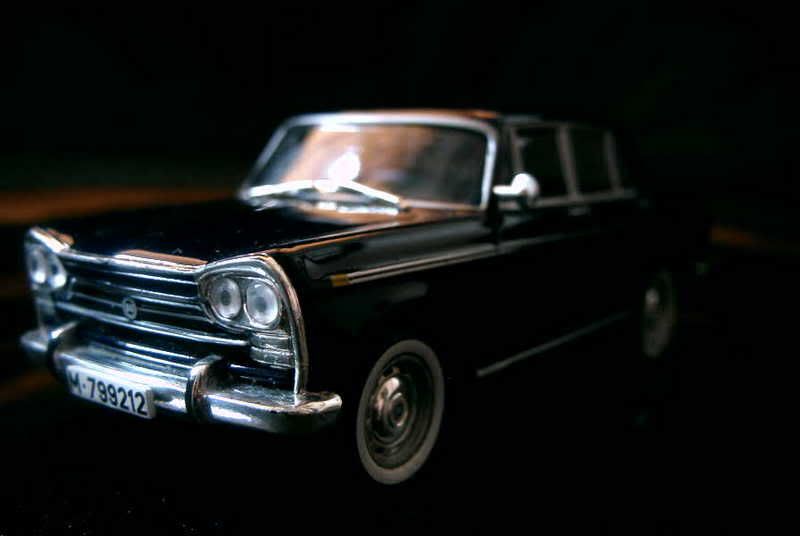
A little history
Spain had had a lively automotive industry at an early time, but it was virtually wiped out by the effects of the competition offered by imported cars, the world economic crisis that followed the Wall Street crash and three years of civil war. In 1950, the Spanish authorities decided to resume the production of an automobile on the national soil, and sought Fiat’s assistance. In November 1953, the first SEAT (Sociedad Española de Automóviles de Turismo, or “Touring Cars Spanish Company”) was assembled in Barcelona from parts shipped from Italy; the car, named Seat 1400, was virtually identical to the new Fiat 1400 mid-range saloon.
By 1960, the bulbous, bathtub-styled 1400 was looking old, even on a virtually closed market as the Spanish one. Though this initial car remained in production for a few more years, a new 1400C, technically similar but totally different on the outside, was released. The 1400C was actually based on the new 1800 and 2100 six-cylinder saloons Fiat had introduced the year before; the Seat management immediately decided to adopt their elegant Pininfarina body, while sticking to the trusted 1.4-litre four, much better suited to the means of the average Spanish motorist of the time.
In 1963, a roomy estate version was added to the 1400C range, while a Seat 1500 based on the Fiat 1500L, a simplified and more economical version of the 1800/2100, was also introduced. Production of all 1400 models was stopped during the following year, the estate version being maintained in production with the 1.5-litre engine fitted.
When in 1968 Seat introduced its 124, based on the Fiat bearing the same name, the attention of most customers switched to this modern vehicle, compared to which the 1500 suddenly looked antiquated. Despite this, the old car kept a strong following when it came to commercial purposes. Spacious and chrome-laden, the 1500 made a popular taxi on the streets of all Spanish cities, while Seat had developed an indigenous pickup variant of the car. Furthermore, the Spanish manufacturer introduced a diesel version, powered by a 1.8-litre provided by Mercedes-Benz. The engines from this diesel pioneer were known to offer remarkable fuel economy and unbeatable reliability and durability, albeit at the cost of abysmal performance. Later, a 2.0-litre Perkins also became available. Both became favourites among Spanish taxi drivers.
Despite a last-minute facelift, the 1500 receiving in 1969 the quad-headlight front of the Fiat 2300, the model retired in 1972, giving way to the Seat 132. Production tally stood at 48,000 for the Seat 1400C, and 135,000 for the Seat 1500, mostly sold on the domestic market. The car today remains as an icon of an era of the Spanish motoring history and, furthermore, of Spanish history as a whole.
About the model
With some logic, Altaya catered to the Spanish public with many variants of Seat 1500 saloons and estates. Unfortunately, those are rather hard to find outside of Spain. Right now, I have to content myself with the most common of them all.
Model: Seat 1500
Year: 1971
Maker: Ixo
Scale: 1/43
Distributed by: Altaya as no.1 of its Nuestros Queridos Coches press series
Acquired: new with neither box nor stand (probably a production overrun or quality control reject), in December 2006, in Hong Kong, S.A.R.
Too bad Altaya doesn’t sell models as this one outside of Spain. They’re probably right in thinking that the small number of collectors interested in, or even having heard of, the Seat 1500 outside of its native country is rather slim, but as of myself I grabbed this one as soon as I found it. No regret whatsoever: this die-cast is splendid, correctly detailed and painted in a superb dark blue hue. A 14/20 rating seems amply justified to me.









2 comments:
There aren´t hardly cars like this in our streets, but when I see one, I can´t stop to contemplate it
I can understand you - I do just the same. Well, not with Seats as this one as I never saw any in my whole life, but with many cars of that era, as they're now becoming so scarce as you said.
Post a Comment